23. A Bayesian Formulation of Friedman and Wald’s Problem#
Contents
23.1. Overview#
This lecture revisits the statistical decision problem presented to Milton Friedman and W. Allen Wallis during World War II when they were analysts at the U.S. Government’s Statistical Research Group at Columbia University.
In this lecture, we described how Abraham Wald [Wald, 1947] solved the problem by extending frequentist hypothesis testing techniques and formulating the problem sequentially.
Note
Wald’s idea of formulating the problem sequentially created links to the dynamic programming that Richard Bellman developed in the 1950s.
As we learned in probability with matrices and two meanings of probability, a frequentist statistician views a probability distribution as measuring relative frequencies of a statistic that he anticipates constructing from a very long sequence of i.i.d. draws from a known probability distribution.
That known probability distribution is his ‘hypothesis’.
A frequentist statistician studies the distribution of that statistic under that known probability distribution
when the distribution is a member of a set of parameterized probability distribution, his hypothesis takes the form of a particular parameter vector.
this is what we mean when we say that the frequentist statistician ‘conditions on the parameters’
he regards the parameters that are fixed numbers, known to nature, but not to him.
the statistician copes with his ignorane of those parameters by constructing the type I and type II errors associated with frequentist hypothesis testing.
In this lecture, we reformulate Friedman and Wald’s problem by transforming our point of view from the ‘objective’ frequentist perspective of this lecture to an explicitly ‘subjective’ perspective taken by a Bayesian decision maker who regards parameters not as fixed numbers but as (hidden) random variables that are jointly distributed with the random variables that can be observed by sampling from that joint distribution.
To form that joint distribution, the Bayesian statistician supplements the conditional distributions used by the frequentist statistician with a prior probability distribution over the parameters that representive his personal, subjective opinion about those them.
To proceed in the way, we endow our decision maker with
an initial prior subjective probability
faith in Bayes’ law as a way to revise his subjective beliefs as observations on
a loss function that tells how the decision maker values type I and type II errors.
In our previous frequentist version, key ideas in play were:
Type I and type II statistical errors
a type I error occurs when you reject a null hypothesis that is true
a type II error occurs when you accept a null hypothesis that is false
Abraham Wald’s sequential probability ratio test
The power of a statistical test
The critical region of a statistical test
A uniformly most powerful test
In this lecture about a Bayesian reformulation of the problem, additional ideas at work are
an initial prior probability
Bayes’ Law
a sequence of posterior probabilities that model
dynamic programming
This lecture uses ideas studied in this lecture, this lecture, and this lecture.
We’ll begin with some imports:
import numpy as np
import matplotlib.pyplot as plt
from numba import jit, prange, float64, int64
from numba.experimental import jitclass
from math import gamma
23.2. A Dynamic Programming Approach#
The following presentation of the problem closely follows Dmitri Berskekas’s treatment in Dynamic Programming and Stochastic Control [Bertsekas, 1975].
A decision-maker can observe a sequence of draws of a random variable
He (or she) wants to know which of two probability distributions
Conditional on knowing that successive observations are drawn from distribution
Conditional on knowing that successive observations are drawn from distribution
But the observer does not know which of the two distributions generated the sequence.
For reasons explained in Exchangeability and Bayesian Updating, this means that the sequence is not IID.
The observer has something to learn, namely, whether the observations are drawn from
The decision maker wants to decide which of the two distributions is generating outcomes.
We adopt a Bayesian formulation.
The decision maker begins with a prior probability
Note
In Bertsekas [1975], the belief is associated with the distribution
After observing
which is calculated recursively by applying Bayes’ law:
After observing
which is a mixture of distributions
To illustrate such a distribution, let’s inspect some mixtures of beta distributions.
The density of a beta probability distribution with parameters
The next figure shows two beta distributions in the top panel.
The bottom panel presents mixtures of these distributions, with various mixing probabilities
@jit
def p(x, a, b):
r = gamma(a + b) / (gamma(a) * gamma(b))
return r * x**(a-1) * (1 - x)**(b-1)
f0 = lambda x: p(x, 1, 1)
f1 = lambda x: p(x, 9, 9)
grid = np.linspace(0, 1, 50)
fig, axes = plt.subplots(2, figsize=(10, 8))
axes[0].set_title("Original Distributions")
axes[0].plot(grid, f0(grid), lw=2, label="$f_0$")
axes[0].plot(grid, f1(grid), lw=2, label="$f_1$")
axes[1].set_title("Mixtures")
for π in 0.25, 0.5, 0.75:
y = (1 - π) * f0(grid) + π * f1(grid)
axes[1].plot(y, lw=2, label=fr"$\pi_k$ = {π}")
for ax in axes:
ax.legend()
ax.set(xlabel="$z$ values", ylabel="probability of $z_k$")
plt.tight_layout()
plt.show()
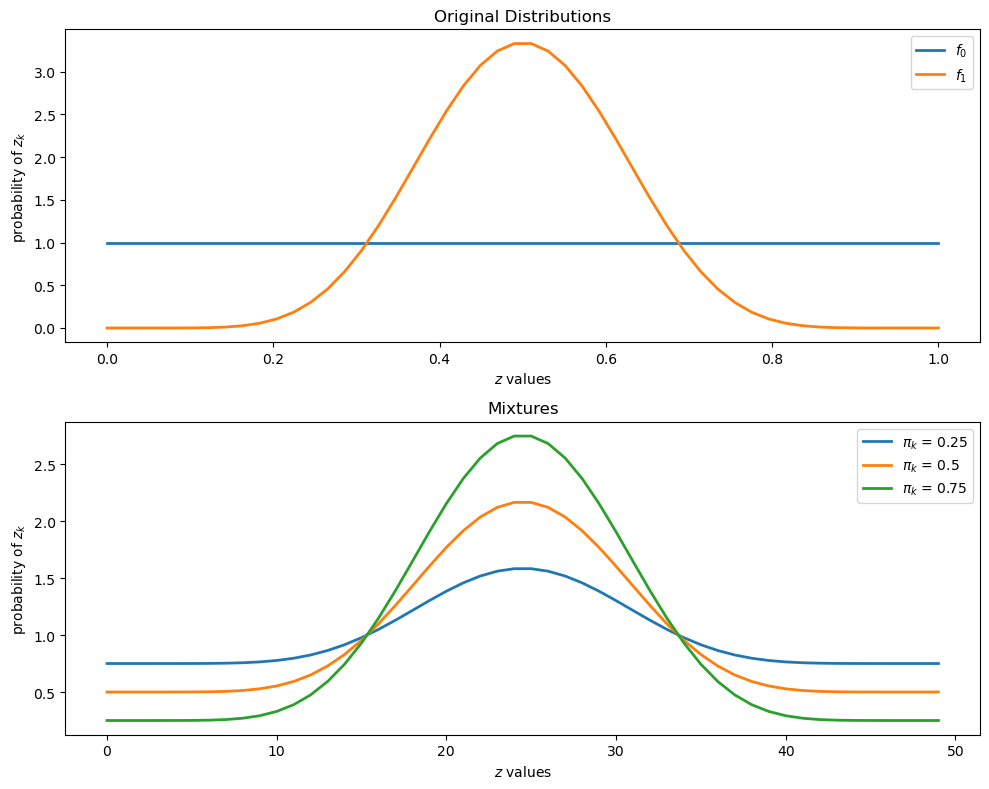
23.2.1. Losses and Costs#
After observing
He decides that
He decides that
He postpones deciding now and instead chooses to draw a
Associated with these three actions, the decision-maker can suffer three kinds of losses:
A loss
A loss
A cost
23.2.2. Digression on Type I and Type II Errors#
If we regard
a type I error is an incorrect rejection of a true null hypothesis (a “false positive”)
a type II error is a failure to reject a false null hypothesis (a “false negative”)
So when we treat
We can think of
We can think of
23.2.3. Intuition#
Before proceeding, let’s try to guess what an optimal decision rule might look like.
Suppose at some given point in time that
Then our prior beliefs and the evidence so far point strongly to
If, on the other hand,
Finally, if
This reasoning suggests a sequential decision rule that we illustrate in the following figure:

As we’ll see, this is indeed the correct form of the decision rule.
Our problem is to determine threshold values
You might like to pause at this point and try to predict the impact of a
parameter such as
23.2.4. A Bellman Equation#
Let
With some thought, you will agree that
where
when
In the Bellman equation, minimization is over three actions:
Accept the hypothesis that
Accept the hypothesis that
Postpone deciding and draw again
We can represent the Bellman equation as
where
The optimal decision rule is characterized by two numbers
and
The optimal decision rule is then
Our aim is to compute the cost function
To make our computations manageable, using (23.2), we can write the continuation cost
The equality
is an equation in an unknown function
Note
Such an equation is called a functional equation.
Using the functional equation, (23.4), for the continuation cost, we can back out optimal choices using the right side of (23.2).
This functional equation can be solved by taking an initial guess and iterating to find a fixed point.
Thus, we iterate with an operator
23.3. Implementation#
First, we will construct a jitclass to store the parameters of the model
wf_data = [('a0', float64), # Parameters of beta distributions
('b0', float64),
('a1', float64),
('b1', float64),
('c', float64), # Cost of another draw
('π_grid_size', int64),
('L0', float64), # Cost of selecting f0 when f1 is true
('L1', float64), # Cost of selecting f1 when f0 is true
('π_grid', float64[:]),
('mc_size', int64),
('z0', float64[:]),
('z1', float64[:])]
@jitclass(wf_data)
class WaldFriedman:
def __init__(self,
c=1.25,
a0=1,
b0=1,
a1=3,
b1=1.2,
L0=25,
L1=25,
π_grid_size=200,
mc_size=1000):
self.a0, self.b0 = a0, b0
self.a1, self.b1 = a1, b1
self.c, self.π_grid_size = c, π_grid_size
self.L0, self.L1 = L0, L1
self.π_grid = np.linspace(0, 1, π_grid_size)
self.mc_size = mc_size
self.z0 = np.random.beta(a0, b0, mc_size)
self.z1 = np.random.beta(a1, b1, mc_size)
def f0(self, x):
return p(x, self.a0, self.b0)
def f1(self, x):
return p(x, self.a1, self.b1)
def f0_rvs(self):
return np.random.beta(self.a0, self.b0)
def f1_rvs(self):
return np.random.beta(self.a1, self.b1)
def κ(self, z, π):
"""
Updates π using Bayes' rule and the current observation z
"""
f0, f1 = self.f0, self.f1
π_f0, π_f1 = (1 - π) * f0(z), π * f1(z)
π_new = π_f1 / (π_f0 + π_f1)
return π_new
As in the optimal growth lecture, to approximate a continuous value function
We iterate at a finite grid of possible values of
When we evaluate
We define the operator function Q below.
@jit(nopython=True, parallel=True)
def Q(h, wf):
c, π_grid = wf.c, wf.π_grid
L0, L1 = wf.L0, wf.L1
z0, z1 = wf.z0, wf.z1
mc_size = wf.mc_size
κ = wf.κ
h_new = np.empty_like(π_grid)
h_func = lambda p: np.interp(p, π_grid, h)
for i in prange(len(π_grid)):
π = π_grid[i]
# Find the expected value of J by integrating over z
integral_f0, integral_f1 = 0, 0
for m in range(mc_size):
π_0 = κ(z0[m], π) # Draw z from f0 and update π
integral_f0 += min(π_0 * L0, (1 - π_0) * L1, h_func(π_0))
π_1 = κ(z1[m], π) # Draw z from f1 and update π
integral_f1 += min(π_1 * L0, (1 - π_1) * L1, h_func(π_1))
integral = ((1 - π) * integral_f0 + π * integral_f1) / mc_size
h_new[i] = c + integral
return h_new
To solve the key functional equation, we will iterate using Q to find the fixed point
@jit
def solve_model(wf, tol=1e-4, max_iter=1000):
"""
Compute the continuation cost function
* wf is an instance of WaldFriedman
"""
# Set up loop
h = np.zeros(len(wf.π_grid))
i = 0
error = tol + 1
while i < max_iter and error > tol:
h_new = Q(h, wf)
error = np.max(np.abs(h - h_new))
i += 1
h = h_new
if error > tol:
print("Failed to converge!")
return h_new
23.4. Analysis#
Let’s inspect outcomes.
We will be using the default parameterization with distributions like so
wf = WaldFriedman()
fig, ax = plt.subplots(figsize=(10, 6))
ax.plot(wf.f0(wf.π_grid), label="$f_0$")
ax.plot(wf.f1(wf.π_grid), label="$f_1$")
ax.set(ylabel="probability of $z_k$", xlabel="$z_k$", title="Distributions")
ax.legend()
plt.show()
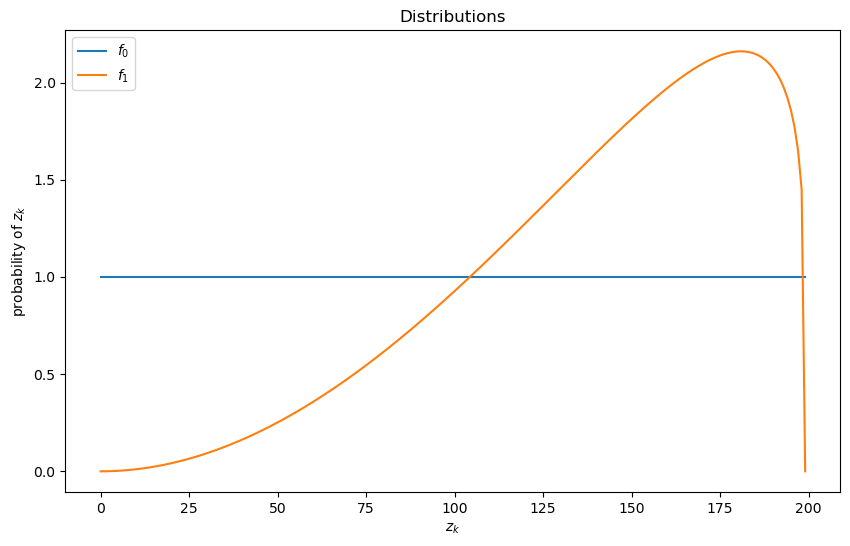
23.4.1. Cost Function#
To solve the model, we will call our solve_model function
h_star = solve_model(wf) # Solve the model
We will also set up a function to compute the cutoffs
@jit
def find_cutoff_rule(wf, h):
"""
This function takes a continuation cost function and returns the
corresponding cutoffs of where you transition between continuing and
choosing a specific model
"""
π_grid = wf.π_grid
L0, L1 = wf.L0, wf.L1
# Evaluate cost at all points on grid for choosing a model
cost_f0 = π_grid * L0
cost_f1 = (1 - π_grid) * L1
# Find B: largest π where cost_f0 <= min(cost_f1, h)
optimal_cost = np.minimum(np.minimum(cost_f0, cost_f1), h)
choose_f0 = (cost_f0 <= cost_f1) & (cost_f0 <= h)
if np.any(choose_f0):
B = π_grid[choose_f0][-1] # Last point where we choose f0
else:
assert False, "No point where we choose f0"
# Find A: smallest π where cost_f1 <= min(cost_f0, h)
choose_f1 = (cost_f1 <= cost_f0) & (cost_f1 <= h)
if np.any(choose_f1):
A = π_grid[choose_f1][0] # First point where we choose f1
else:
assert False, "No point where we choose f1"
return (B, A)
B, A = find_cutoff_rule(wf, h_star)
cost_L0 = wf.π_grid * wf.L0
cost_L1 = (1 - wf.π_grid) * wf.L1
fig, ax = plt.subplots(figsize=(10, 6))
ax.plot(wf.π_grid, h_star, label='sample again')
ax.plot(wf.π_grid, cost_L1, label='choose f1')
ax.plot(wf.π_grid, cost_L0, label='choose f0')
ax.plot(wf.π_grid,
np.amin(np.column_stack([h_star, cost_L0, cost_L1]),axis=1),
lw=15, alpha=0.1, color='b', label=r'$J(\pi)$')
ax.annotate(r"$B$", xy=(B + 0.01, 0.5), fontsize=14)
ax.annotate(r"$A$", xy=(A + 0.01, 0.5), fontsize=14)
plt.vlines(B, 0, (1 - B) * wf.L1, linestyle="--")
plt.vlines(A, 0, A * wf.L0, linestyle="--")
ax.set(xlim=(0, 1), ylim=(0, 0.5 * max(wf.L0, wf.L1)), ylabel="cost",
xlabel=r"$\pi$", title=r"Cost function $J(\pi)$")
plt.legend(borderpad=1.1)
plt.show()
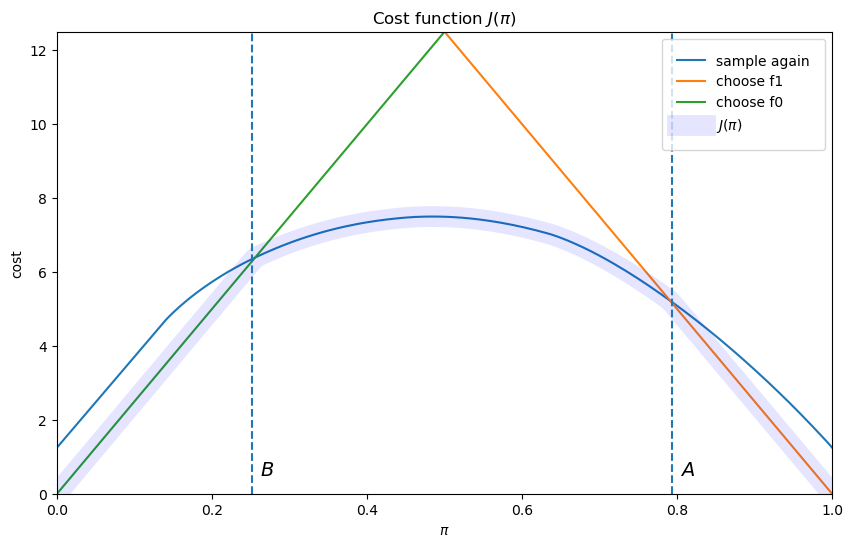
The cost function
The slopes of the two linear pieces of the cost function
The cost function
The decision-maker continues to sample until the probability that he attaches to
model
23.4.2. Simulations#
The next figure shows the outcomes of 500 simulations of the decision process.
On the left is a histogram of stopping times, i.e., the number of draws of
The average number of draws is around 6.6.
On the right is the fraction of correct decisions at the stopping time.
In this case, the decision-maker is correct 80% of the time
def simulate(wf, true_dist, h_star, π_0=0.5):
"""
This function takes an initial condition and simulates until it
stops (when a decision is made)
"""
f0, f1 = wf.f0, wf.f1
f0_rvs, f1_rvs = wf.f0_rvs, wf.f1_rvs
π_grid = wf.π_grid
κ = wf.κ
if true_dist == "f0":
f, f_rvs = wf.f0, wf.f0_rvs
elif true_dist == "f1":
f, f_rvs = wf.f1, wf.f1_rvs
# Find cutoffs
B, A = find_cutoff_rule(wf, h_star)
# Initialize a couple of useful variables
decision_made = False
π = π_0
t = 0
while decision_made is False:
z = f_rvs()
t = t + 1
π = κ(z, π)
if π < B:
decision_made = True
decision = 0
elif π > A:
decision_made = True
decision = 1
if true_dist == "f0":
if decision == 0:
correct = True
else:
correct = False
elif true_dist == "f1":
if decision == 1:
correct = True
else:
correct = False
return correct, π, t
def stopping_dist(wf, h_star, ndraws=250, true_dist="f0"):
"""
Simulates repeatedly to get distributions of time needed to make a
decision and how often they are correct
"""
tdist = np.empty(ndraws, int)
cdist = np.empty(ndraws, bool)
for i in range(ndraws):
correct, π, t = simulate(wf, true_dist, h_star)
tdist[i] = t
cdist[i] = correct
return cdist, tdist
def simulation_plot(wf):
h_star = solve_model(wf)
ndraws = 500
cdist, tdist = stopping_dist(wf, h_star, ndraws)
fig, ax = plt.subplots(1, 2, figsize=(16, 5))
ax[0].hist(tdist, bins=np.max(tdist))
ax[0].set_title(f"Stopping times over {ndraws} replications")
ax[0].set(xlabel="time", ylabel="number of stops")
ax[0].annotate(f"mean = {np.mean(tdist)}", xy=(max(tdist) / 2,
max(np.histogram(tdist, bins=max(tdist))[0]) / 2))
ax[1].hist(cdist.astype(int), bins=2)
ax[1].set_title(f"Correct decisions over {ndraws} replications")
ax[1].annotate(f"% correct = {np.mean(cdist)}",
xy=(0.05, ndraws / 2))
plt.show()
simulation_plot(wf)
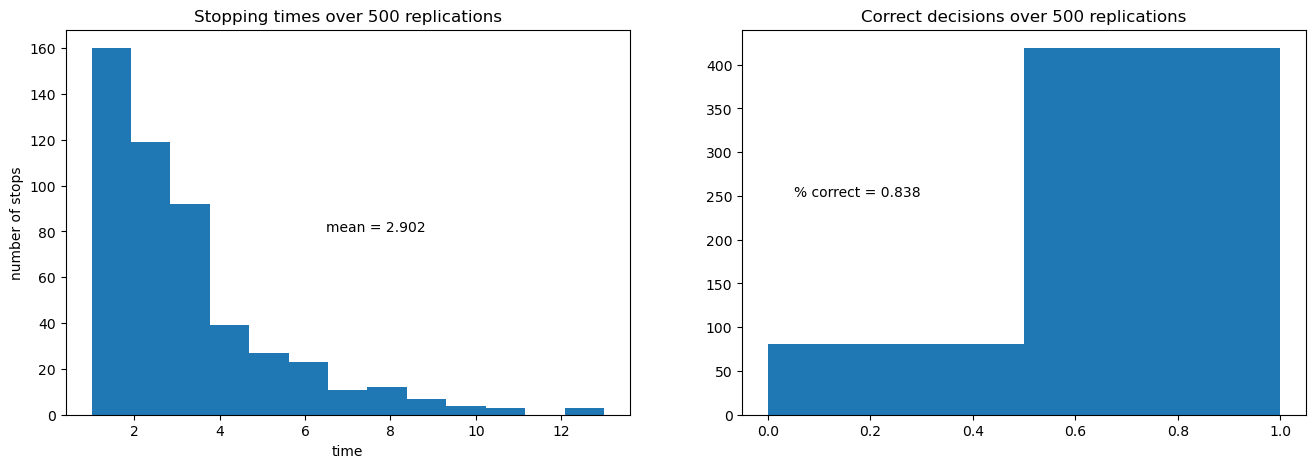
23.4.3. Comparative Statics#
Now let’s consider the following exercise.
We double the cost of drawing an additional observation.
Before you look, think about what will happen:
Will the decision-maker be correct more or less often?
Will he make decisions sooner or later?
wf = WaldFriedman(c=2.5)
simulation_plot(wf)
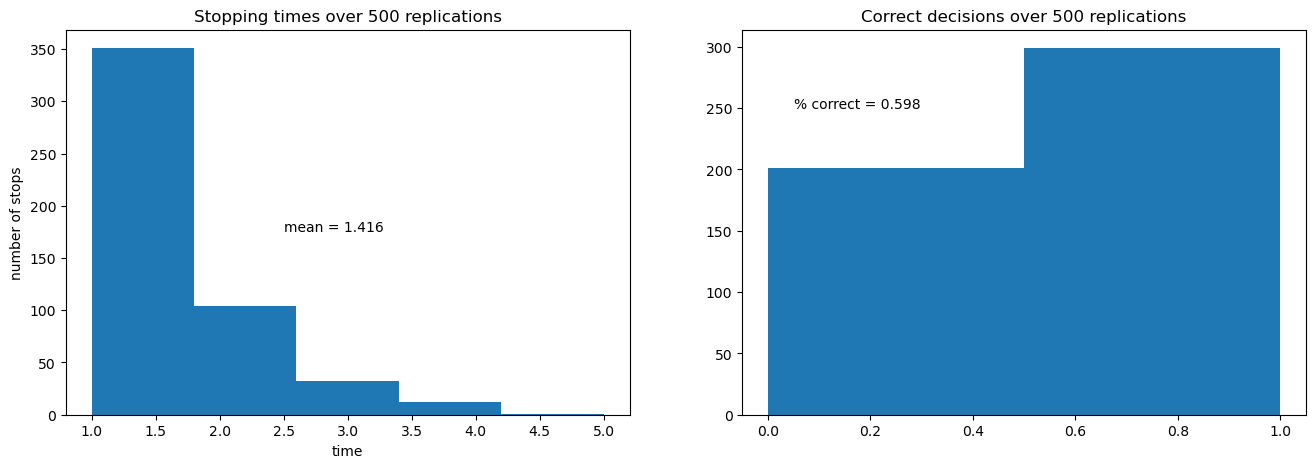
Increased cost per draw has induced the decision-maker to take fewer draws before deciding.
Because he decides with fewer draws, the percentage of time he is correct drops.
This leads to him having a higher expected loss when he puts equal weight on both models.
To facilitate comparative statics, we invite you to adjust the parameters of the model and investigate
effects on the smoothness of the value function in the indecisive middle range as we increase the number of grid points in the piecewise linear approximation.
effects of different settings for the cost parameters
various simulations from
associated histograms of correct and incorrect decisions.